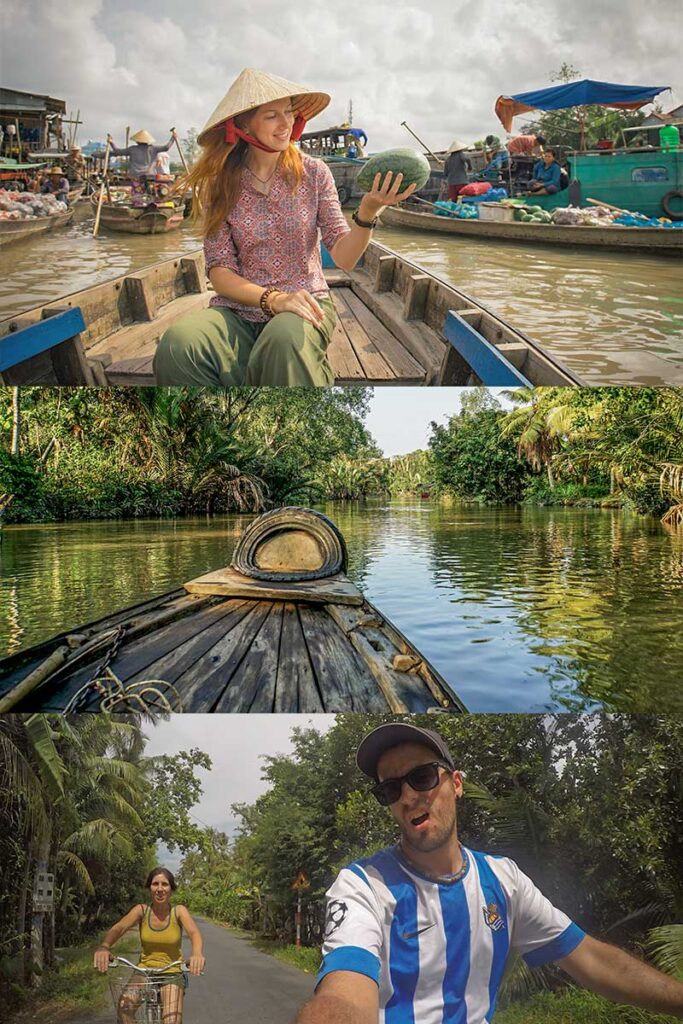What are the Mekong Delta floating markets?
Floating markets in the Mekong Delta grew naturally out of the region’s geography and way of life. The delta is a maze of rivers and canals where farms sit right on the water’s edge, so for generations the simplest way to transport goods was by boat. Over time, certain river junctions became busy meeting points, turning into regular markets that floated on the water.
Why they emerged
The Mekong Delta is Vietnam’s “rice bowl,” producing not only rice but also tropical fruits and vegetables. Before modern bridges and roads, waterways were the highways of the region. Farmers loaded their produce directly onto boats and paddled to river crossroads, where they could meet buyers and other traders. To show what they were selling, vendors used tall bamboo poles called cây bẹo, hanging a sample of their goods (like a pineapple, pumpkin, or coconut) for everyone to see from a distance.

How trading worked
The markets were once dominated by big “mother boats” that carried wholesale loads of rice, fruit, or vegetables. Smaller boats would come alongside, buy in bulk, and bring the goods further inland to villages or to Ho Chi Minh City. At the same time, little sampans acted like mobile cafés, selling coffee, noodle soup, or snacks to traders working long mornings on the water. For visitors today, these food boats often end up being the highlight of a market visit.
Where they form
Floating markets typically formed where two or more rivers or canals meet, making them natural hubs for trade. Some markets were wholesale centers serving the wider region, while others functioned more like local retail markets with smaller boats. This is why Cai Rang once felt huge and busy, while Phong Dien was always smaller and more intimate. Each market’s character depended on its location and what products were grown nearby.
The reality of the floating markets today (2026)
Why they declined
For most of the 20th century, floating markets were the lifeblood of the Mekong Delta. But over the past two decades, new highways, bridges, and container trucks have made it faster and cheaper to move goods by land.
COVID-19 accelerated the decline: many traders stopped working on the river during restrictions and never returned. Younger generations are also looking for easier, more stable jobs, leaving the floating markets to only a handful of families who can’t or don’t want to move ashore.
Policy & preservation moves
Authorities in Can Tho have tried to preserve Cai Rang Floating Market, officially recognizing it as intangible cultural heritage and setting up a management board to regulate activities. But even with preservation plans, practical obstacles remain. Embankments along the river, built to prevent erosion, have made it harder for trading boats to connect with the shore. The result is that even if money is spent on “reviving” the market, it is more likely to survive as a tourism product than as a genuine wholesale hub.
Photo vs reality
Many of the vibrant photos you’ll see online were taken years ago. Today, an early morning visit often shows far fewer trading boats, with tour boats making up much of the traffic. You may still see a coffee boat or a woman cooking breakfast on her sampan, but the buzzing wholesale atmosphere is gone. For travellers, the experience is more about the river at sunrise than a busy market scene.
What still operates
Here’s what you can realistically expect in 2025:
- Operating as a tourist-leaning market: Cai Rang (Can Tho) – still the main stop for tours, with a mix of fruit and food boats alongside tourist traffic.
- Sparse/local lifestyle boats; minimal trade: Long Xuyen (An Giang) – a handful of sellers remain, mainly serving locals, but the peaceful river ride at dawn can still be enjoyable.
- Reported closed/vanished or moved onshore: Phong Dien, Cai Be, Tra On, Nga Nam, Nga Bay – once important markets, but now either shut down, reduced to only a couple of boats, or replaced entirely by land markets.
Are the floating markets still worth visiting?
When they are
They can still be worthwhile if you approach them as part of a wider Mekong morning rather than the main attraction. Sipping coffee or slurping a bowl of pho on a boat at sunrise is a special experience, and the soft light makes for good photography. Afterward, drifting into the smaller canals or visiting a local land market can turn the outing into something memorable.
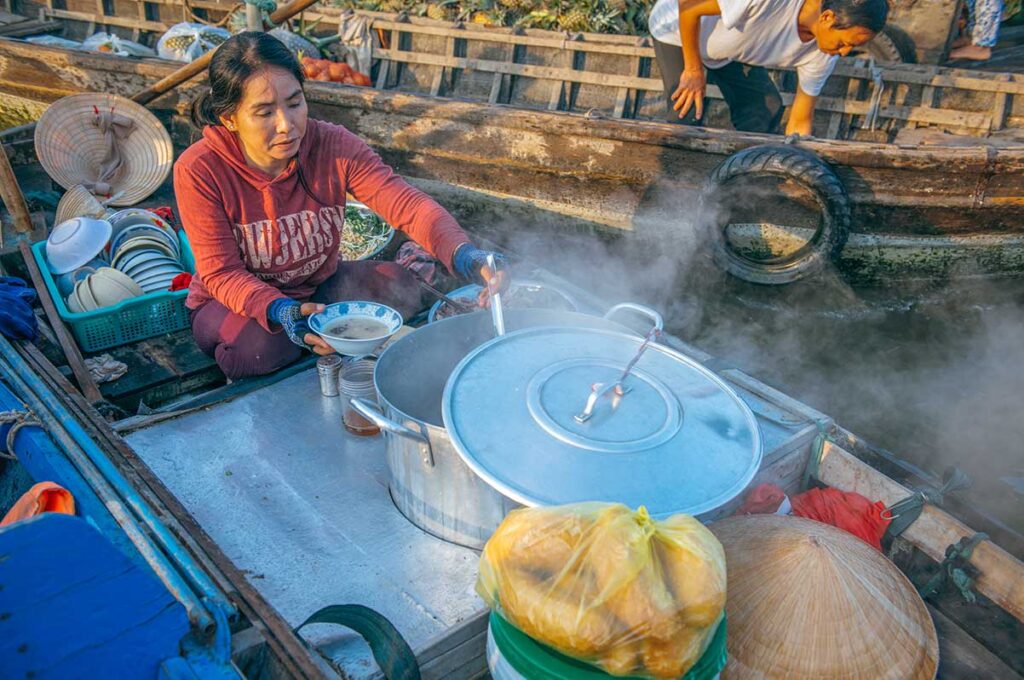
When they’re not
If your expectation is to see a huge wholesale market with hundreds of boats jostling for space, you’ll be disappointed. The reality today is far quieter, with fewer traders and more tour boats. For travellers who make the floating market the sole reason to come to the delta, the experience often feels underwhelming.
Mindset tips
Treat the floating market as just one stop in a broader river journey. Think of it as a chance to glimpse river life, have breakfast on the water, and then continue through the back canals or visit orchards and villages. With that mindset, you’re less likely to compare it to the old photos and more likely to enjoy the slower, more intimate experience that’s left.
The best floating markets in the Mekong Delta
Not every market is “best” in the traditional sense anymore, but these are the names travellers will still come across. Below is the real status of each, with background, what to expect today, and how to approach a visit.
1. Cai Rang Floating Market (Can Tho)
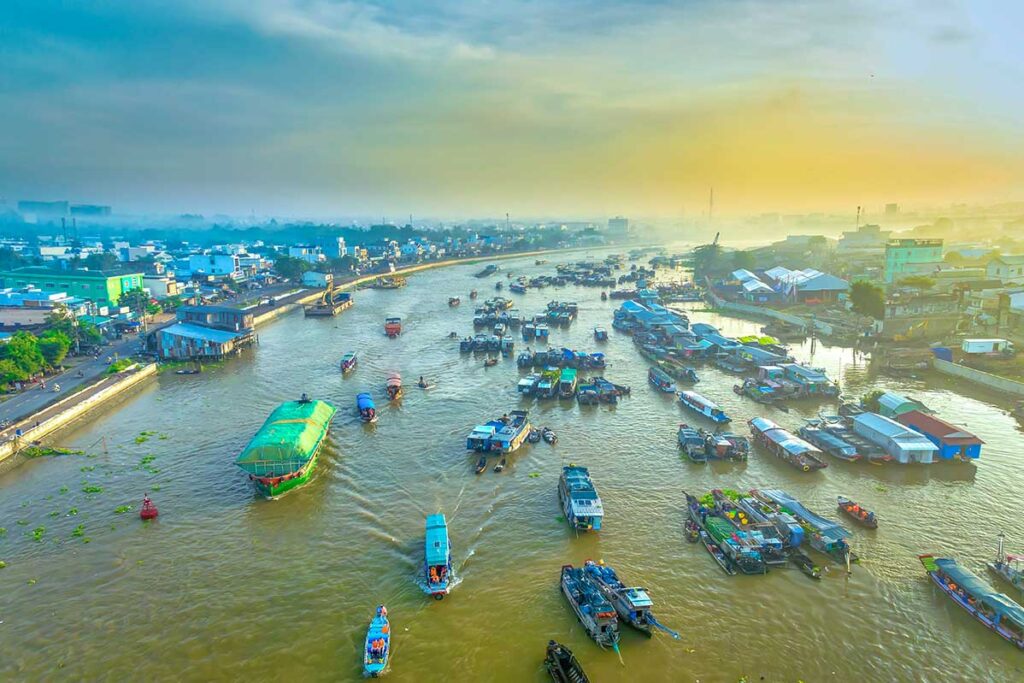
Cai Rang was once the largest wholesale floating market in the delta and remains a cultural symbol of Can Tho. For decades, it was where boats from across the region gathered to sell fruit, vegetables, and rice. It’s also the market most often featured in travel guides and photos, which makes it the most visited today.
What about today?
The number of trading boats has dropped sharply, and tourist boats often outnumber seller boats. Preservation efforts are ongoing, but the atmosphere is more subdued than the vibrant images online suggest. Still, Cai Rang is the best chance to see fruit boats, pho sampans, and some of the remaining river trade in action.
Base yourself in Can Tho for an early start and aim to be on the water between 5:30 and 7:00 a.m. After the market, add side trips through small canals or stops at a cacao farm or noodle workshop to make the morning more rewarding.
The Real Mekong Delta Homestay Experience & Floating Markets Tour
- Experience Homestay in Can Tho with cycling through villages and rice fields.
- Highlights Cai Rang & Phong Dien floating markets with early-morning boat trip.
2. Long Xuyen Floating Market (An Giang)

Located on the Hau River, just outside Long Xuyen City, this floating market once served as a local trading hub rather than a tourist attraction. It has always been less known than Cai Rang, which gave it a more authentic, everyday feel.
Long Xuyen today?
The market is now very quiet, with only a handful of boats selling coffee, noodles, or daily goods. Many locals have moved their trading to land, leaving mostly lifestyle boats and a scattering of sellers. It no longer feels like a real “market,” but the river at sunrise can still be atmospheric.
Worth considering only if you’re already in An Giang (for example, en route to Chau Doc or Sam Mountain). Treat it as a peaceful dawn boat ride, then explore Long Xuyen’s land markets or other nearby sights afterward.
3. Phong Dien Floating Market (Can Tho)
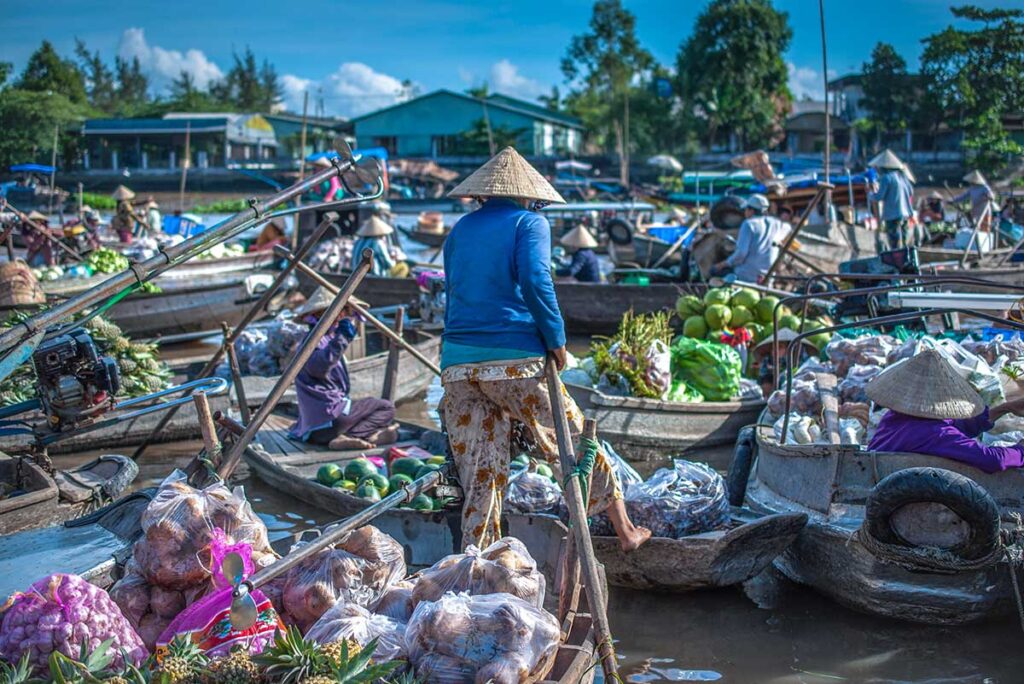
Phong Dien Floating Market was once known as the small-boat “retail” counterpart to Cai Rang, selling not just produce but also household items and fishing gear. It was more intimate and community-driven than its larger neighbor.
The reaility of Phong Dien today?
Most reports suggest it has been closed since COVID and has not truly returned. Some boatmen claim a few traders still gather, but even locals often describe it as no longer functioning. Travellers should not plan a visit solely around this market.
If you’re offered a trip to Phong Dien, ask to see recent photos or clarify what’s actually running that day. Otherwise, spend the time in Can Tho’s smaller canals, which usually give a better glimpse of local life.
4. Cai Be Floating Market (Tien Giang)

Cai Be, located close to Ho Chi Minh City, used to be one of the most convenient floating markets to visit on a short trip. It was a mix of wholesale trade and retail aimed at both locals and visitors.
Cai Be Floating Market is closed
The floating market is now considered permanently closed, with bridge construction taking place at the old site. Tours in Cai Be typically focus instead on canals, orchards, and craft villages (like candy making), rather than a functioning market.
If you’re staying in Cai Be, set clear expectations with your guide or operator—ask for canal rides and orchards rather than “floating market.” Also make it clear if you want to avoid souvenir factory stops, which are often added in.
Mekong Lodge Local Experience in Cai Be
- Experience: Riverside bungalow stay with cycling, sampan boat ride, and cooking class.
- Highlights: Cai Be boat tour and local handicraft workshops included.
5. Tra On Floating Market (Vinh Long)

Tra On was once known as a tide-dependent wholesale market, busiest at dawn when the Hau River was at its peak. It was especially lively for fruit and seasonal produce.
Tra On Floating Market is closed
It has not reopened since the pandemic and is considered closed. Boats no longer gather in the early morning as they once did.
If you’re in Vinh Long, treat any boat outing here as a scenic river cruise instead of a market visit. Local land markets are a better option for a taste of daily trade.
6. Nga Nam Floating Market (Soc Trang)
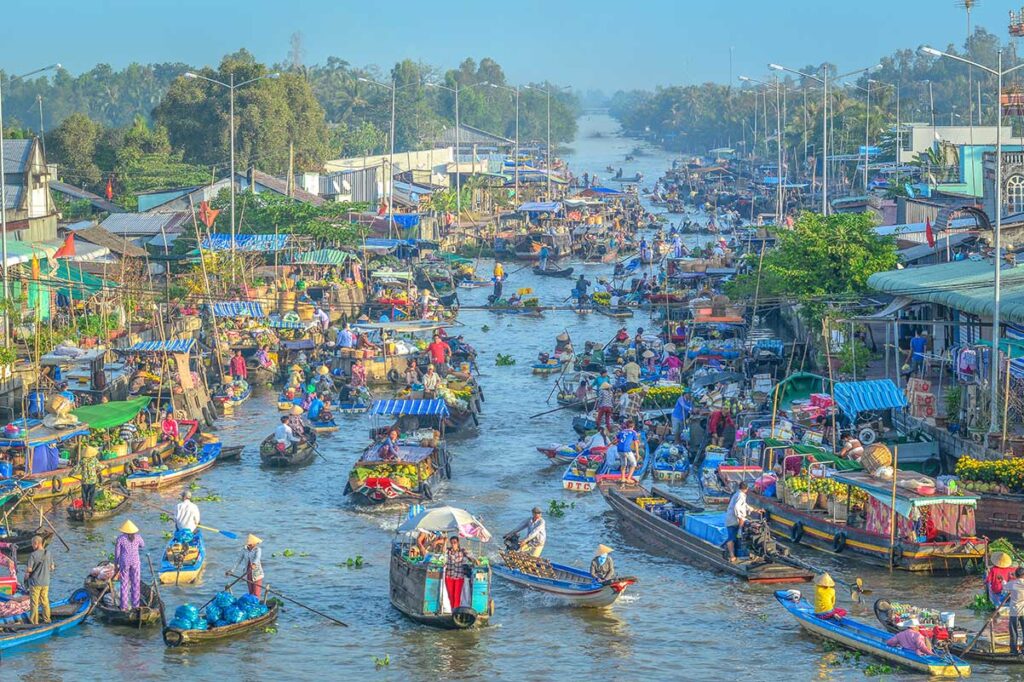
Nga Nam was famous for its five-river junction location, which made it one of the busiest crossroads markets in the delta. It had a reputation for variety, from rice and produce to fish and even household goods.
Nga Nam Floating Market is closed
Since COVID, the floating market has effectively moved onshore. A couple of food boats may still show up, but the bustling boat-to-boat trading that once defined Nga Nam is gone.
Expect land market activity rather than a river market. If you’re offered a rowboat trip, negotiate prices clearly, and don’t expect a scene like old photos.
7. Nga Bay (Phung Hiep) Floating Market (Hau Giang)
This was once the classic “seven-river” market, a famous symbol of Hau Giang province with nearly a century of history. It suffered a major decline after being relocated in the 2000s.
Nga Bay is closed
Relocation and attempts at revival never brought back the original vibrancy. Today, Nga Bay is more of a name in history than a functioning floating market, with little left to see on the water.
Don’t build your itinerary around this market. If you’re in Hau Giang, focus instead on countryside scenery or land markets, which provide a more genuine experience.
How to plan a worthwhile floating-market morning
Base yourself right
The only way to catch what’s left of the markets is to stay overnight nearby. Can Tho is the best base, especially for Cai Rang and the surrounding canals. If you’re exploring An Giang, Long Xuyen is the practical option for an early start on the Hau River.
Start times that matter
Markets begin before sunrise. Aim to be on the water by 5:30 a.m. at the latest. By 7:30–8:00, most of the activity has already faded and you’re left with tour boats circling around.
Boat types & pricing
You’ll find two main options: shared boats and private boats. Shared boats are cheaper but leave later, often missing the best hours. Private boats cost more but give you flexibility and a closer look at the action. The easiest way to book is through your hotel or homestay—this avoids touts at the wharf. Always confirm the boat has a roof and proper seating.
Route design that adds value
A market visit alone can feel underwhelming. To make the morning worthwhile, pair it with small canals, a visit to a land market, or stops like a noodle workshop. If you don’t want to be taken to souvenir factories, say so clearly when you book.
Weather & season
Even if you leave in the dark, you’ll be on the water for hours. Bring a rain cover, sunscreen, and a drybag for your camera or phone. A lens cloth is handy for spray and condensation in the humid dawn air.
Cash & small buys
Floating coffee and breakfast boats only take cash. Bring small notes if you want to buy pho, fruit, or a cup of strong Vietnamese coffee.
Photo expectations & etiquette
Don’t expect the crowded boat scenes you’ve seen in old photos. What remains can still be photogenic, especially with the sunrise light, but on a smaller scale. Ask before taking close-up portraits and avoid leaning dangerously out of the boat.
Red flags & realities
Be cautious of operators who promise “hundreds of boats” or “authentic bustling trade.” If you’re unsure, ask to see today’s photos. Also clarify whether the trip includes shopping stops—if you’d rather not be steered to candy workshops or factories, make that clear.
Accessibility notes
Boarding usually means stepping down into a low boat, which can be tricky for anyone with limited mobility. Shade is limited, and not all boats carry lifejackets—ask to see them before departure if that’s important to you.
Alternatives if markets disappoint
If you arrive at a floating market and find only a handful of boats, don’t worry—you can still have a rewarding morning on the water. The Mekong Delta is full of experiences that show daily life, culture, and landscapes beyond the markets. For more inspiration, check out our full list of the best things to do in the Mekong Delta.
Back-canal photography cruise
The small canals are often more atmospheric than the main rivers. Here you’ll pass stilt houses, fruit orchards, and fishermen starting their day, with far fewer tour boats around. For photographers, this is where the Mekong feels most authentic.
Land markets at dawn
Land markets across the delta are lively and genuinely local. Arriving at sunrise, you’ll see farmers unloading fresh produce, fishmongers cleaning their catch, and plenty of breakfast stalls. These markets often feel more vibrant than what remains of the floating markets.
River-life morning
Even if the market itself is quiet, you can still enjoy a Mekong morning by combining coffee or a noodle breakfast on a boat with sunrise views, then continuing through back canals. Adding a short stop at a land market creates a complete experience of daily river life.
Other delta highlights
If markets aren’t the main draw, the region has plenty of other highlights. Seasonal places like Tra Su Forest show the delta’s wetlands at their best. Craft villages, fruit orchards, and Cham villages in An Giang offer cultural depth. These make excellent add-ons to a river tour, ensuring your trip is worthwhile even if the markets underwhelm.


